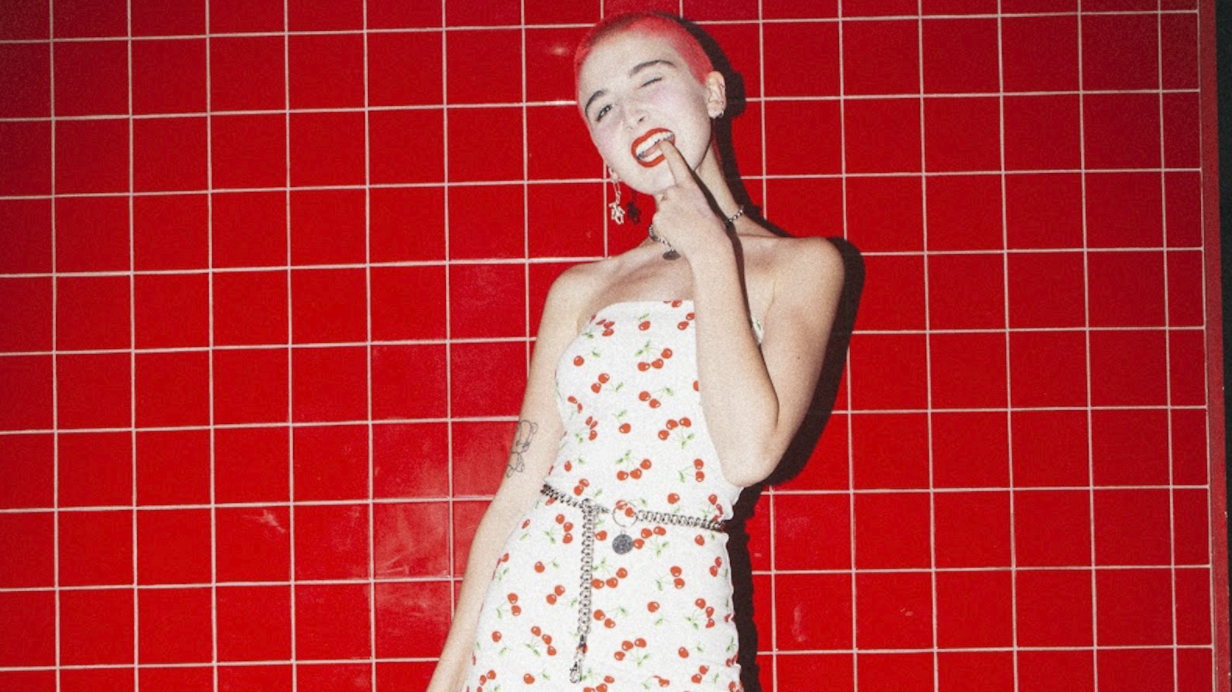The Sudden Rise Of Depop Creators: 2020s Latest Surprise
If there’s one thing the virus can’t keep inside, it’s our creativity, and also our newfound love for second hand clothing.
BY: CLAUDIA MINARDI
Photo courtesy of Depop
There was a period in 2020 where I spent every hour of the day on Instagram.
I had a good reason for it.
My classes for the winter semester had finished and I was taking the summer to recoup (and give my bank account a break). With my sisters continuing their classes online and my parents off to work, I found solace in social media, specifically Instagram.
It was an entertaining hub to keep my mind off the depressing news stories that were on an endless loop. Instagram was where I could chat with my friends and laugh at memes. What really caught my eye were those thrift-flip videos that provided me with tons of fashion inspiration.
As I continued to fall down the hypnotic Instagram rabbit hole, I noticed a pattern in the captions of those beloved clothing posts: they all made it a point to promote their Depop shop.
Depop is a virtual thrift store, founded in 2011 by Simon Beckerman. He wanted an app to accompany his fashion magazine so readers could purchase the featured items. The platform grew from there and is now considered a “global marketplace.”
Despite Depop being around for almost ten years, I had never heard of the app. Fast forward to May of 2020 and it is suddenly all the rage.
I believe it is related to the recent resurgence in vintage fashion. I’ve heard my mom say “the 90s are coming back” so many times over the last few years. Popular items from the past such as mom jeans, bucket hats, tie-dye shirts, and crop tops are all considered must-haves today.
Another contributing factor to Depop’s sudden success in the last while is the reduced stigmatization of thrift shopping. Perhaps it’s related to Mackelmore’s 2013 hit song “Thrift Shop.” On a more realistic note, it may be because the drastic effects of fast fashion are becoming more widespread. Shopping for second hand clothing is no longer looked down upon and is instead becoming trendy.
Photo courtesy of Depop
Depop competes with other online reselling websites like Etsy, Ebay, and Poshmark, to name a few. So what makes Depop stand out?
The answer lies in the app’s main demographic: Generation Z.
Depop is designed just like Instagram, with a feed, a “likes” system to alert other sellers of which items catch your eye, and an instant messaging option to reach out with questions. It’s meant to appeal to the Gen Z kids, who make up 90 percent of the platform’s users.
As strange as I found this Depop craze to be, I understood it. What else are a bunch of out of school and (most likely) unemployed college students supposed to do during a pandemic?
Constant gruelling classes had drained us of our imagination, but with the breather the pandemic had given us, it was time to see what our minds could create. Selling old yet gently used clothes on Depop seemed like the ideal way to make some cash. In fact, Depop recorded an increase in new accounts and overall number of items sold since April 1 of this year. Vice President Marie Petrovicka has attributed this data to the ongoing pandemic, as many people are using Depop as an “alternate source of income.”
Many stores have taken a hit during this pandemic, closing and even filing for bankruptcy. My own friends have lost their jobs because of mall lockdowns, finding themselves stuck at home and applying for government relief funds to compensate. Other companies were finding success in shifting exclusively online until the situation cleared up.
The more I thought about why Depop had become extremely popular, the more I realized it was related to the world’s new way of living.
Photo courtesy of Design Studio
I decided to look into making an account, initially thinking that it couldn’t be too hard. If the platform had gotten a lot of attention within a few months, becoming a “shop” should be a simple process.
After about three YouTube videos explaining how to become a successful seller on Depop, I was ready to abandon my digital thrift store journey.
In all fairness, I have never been that nifty with social media and I have very limited knowledge about business. Unsurprisingly, being well versed in both of these topics is strongly recommended for those wanting to dive into the world of Depop.
I didn’t know what to expect when doing my research, so I felt overwhelmed and confused by all this new information. However, I am not the spokesperson for my generation; many of my friends understand the world of PayPal and how online businesses operate.
Overall, Depop seemed to require more effort than I had originally thought. There were a list of concepts to consider, such as the buyer and seller protection, which prevents customers and shop owners from being scammed while using the app. Reviews are very important when selling on Depop, as getting five star reviews can help build a reputation, resulting in the shop being featured on the “explore page”. Depop, PayPal and the shipping process all take a cut of each sale a seller makes, meaning that a shop owner would have to price their items accordingly to make a decent profit.
On top of it all, Depop is a business. I can list my gently used clothing on the app, but the items may not be guaranteed sellers if they aren’t the latest trend. Vintage fashion is especially popular in the Depop community and may result in other styles getting less attention and sales. At some point, I would have to replenish my store’s stock to maintain my growing business. Unfortunately, that would require me to go thrift shopping, which isn’t an option in the middle of a pandemic.
This made me consider the intentions of Depop: is it just a reselling app, or is it more than that?
The platform initially piqued my interest because it seemed like a straightforward way to sell old clothing. However, Depop’s purpose has expanded past that point and transformed into something darker.
I have scrolled through pages of Reddit threads discussing the ethical dilemma of buying clothing at thrift stores for a low price, then reselling them on Depop for a large profit.
Are resellers taking away from the less fortunate who rely on charity shops for their everyday needs?
I decided to test this theory by scrolling through the Depop app and searching “vintage band shirt”. Two KISS shirts from the late 1980s immediately appeared on my feed and I took a moment to compare the prices. Both shirts were manufactured by the same company, were the same size, and were gently used.
With this in mind, I could not understand why one shirt was listed for $60, while the other was $200. Although thrift store prices fluctuate, I think it’s safe to say that finding a regular shirt for over $100 would be rare.
As I continued to browse Depop, I saw the majority of clothing on the site was between $15 - $30. It could be that the band shirts I came across were outliers, or that the sellers wanted to make a large profit.
On the other hand, there could be a valid reason for the expensive items listed on the app. For instance, the seller might be compensating for the ten percent share Depop takes from the sale.
Although Depop originally sounded like a great way to make some money and clean out my closet, it just wasn’t for me. I would rather wait until the restrictions were lifted so I could donate my clothes to my local Value Village.
However, even though I personally didn’t vibe with Depop, 15 million people from 147 countries around the world do!
Bella McFadden: Photo Courtesy of Galoremag
Once a Depop creator becomes successful enough, they move up and become a “Top Seller.” This title gives them support from the Depop team to maintain their success by giving them more exposure. An added bonus is receiving that lovely, blue checkmark of verification next to their username that we all dream of.
Don’t be fooled, though, as being a top seller isn’t just for the popularity. There are users who are able make a steady income solely on the sale of their clothing.
Take Bella McFadden, for instance. The 24-year-old Depop breakout star from Canada has earned over $1 000 000 and has shifted her focus from selling vintage thrift-flips to her own custom fashion line.
It seems that Depop not only helps its sellers gain some extra cash during this uncertain time, but also break into the fashion industry. I never even considered venturing down that career path, knowing that landing a sustainable job is virtually unattainable.
Luckily, someone in 2020 who is genuinely interested in pursuing a profession in fashion has the tools to make their dream come true.
Photo courtesy of Ella Charlotte Jones
The ongoing pandemic has ironically had a positive impact on many Depop sellers. After browsing the app and viewing a few stores that caught my eye, I realized that reselling old clothes is the bare minimum.
There are sellers who upcycle and spruce up their products by adding a custom design or slogan on the front of a plain shirt. Others make handmade jewelry with beads from their local craft store. I even saw some shops who painted plain, reusable shopping bags to encourage going green.
There was a period of time where face coverings, both medical and non-medical, were either impossible to find or cost more than many could afford. Yet, across the phone screen on the Depop app, creators were sewing their own cloth masks and featured them on their page to promote safety in the chaos.
I find it admirable how thrift shopping went from being looked down upon, to suddenly being the norm. With Depop having so many users, second-hand fashion has never been so in style. The growth in Depop’s popularity during these last few months has simultaneously increased the awareness of fast fashion and some eco-friendly alternatives.
Overall, I feel that Depop makes second hand shopping straightforward and accessible to Gen Z kids, especially during the pandemic. It seems that the online thrift store not only promotes sustainable fashion, but it also provides its young users with entrepreneurial skills and allows them to explore the various ways their ideas can be turned into original products.
Who knows, perhaps I’ll consider making an account and giving Depop a second chance.
Whether it was the constant anxiety of the virus or the craving to do something productive, the 2020 lockdown sparked a creative flame in the minds of young adults across the globe.
All it took was a pandemic to remind us that our imagination cannot be contained.




